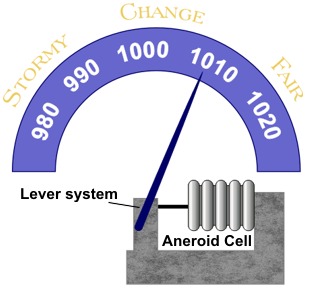Overview
Barometers are instruments used to measure air pressure. Students will make a device for indicating air pressure changes, called an aneroid barometer.
| TOTAL TIME | Construction time 10 minutes. Observation time 5-10 days. |
|---|---|
| SUPPLIES | Straw; Small metal coffee can or glass jar; Plastic wrap; Large index card; Rubber band |
| PRINTED/AV MATERIAL | None |
| TEACHER PREPARATION | None |
| SAFETY FOCUS | Thunderstorms safety |
Procedure
- Cover the top of the coffee can tightly with the plastic wrap, using the rubber band to hold it in place. The cover should be taut and airtight.
- Lay the straw flat across the top with one end at the center and the remaining length of the straw suspended over air. Make sure it is horizontal and tape in place.
- Fold one inch of the short end of the index card at a 90° angle and tape that folded end to the can. It should be positioned right behind the straw, sticking out like a flag, with half of the card above the rim and the horizontal straw looking like a dividing line across the middle of the card.
- Mark the level of the end of the straw onto the card.
- For the next 10 days, at the same time each day, record the level of the straw while paying close attention to how changes in the weather affect the straw's level. It may be helpful to have students record both the weather and the straw level each time they mark the barometer.
Discussion

Barometers using mercury are heavy and fragile. The idea of a "dry" barometer was conceived by Gottfried Wilhelm Leibniz around 1700. It would be a way to detect pressure changes using sealed bellows. The first working version of an aneroid (without water) barometer was built in 1843 by French scientist Lucien Vidie.
This development made the barometer very portable, and it became a commonly used meteorological instrument. However, it still needed to be calibrated to a mercurial barometer, with readings in inches of mercury.
Even as late as the 1990s, National Weather Service offices still calibrated and verified the accuracy of the aneroid barometers with a mercurial barometer.
What the students have constructed is similar to an aneroid barometer. This is the most common type of barometer for home use.
In this case, the aneroid cell is the coffee can. The aneroid cell volume is very sensitive to changes in atmospheric pressure, causing it to expand and contract with those changes Attached to the aneroid cell is a lever indicating the air pressure.
When the barometer is constructed, the air pressure will be the same inside and out.
As air pressure becomes higher in the atmosphere, it will push the plastic wrap down into the can, causing the straw tip to rise, indicating that higher pressure. The opposite will occur when low pressure is in the area. The decrease in air pressure on top of the can will cause the plastic wrap to rise, lowering the straw tip.
Today, electronic sensors have replaced the metal aneroid cell in most barometers. However, those electronic sensors need to be calibrated to ensure their accuracy. For that calibration, we still use mercurial barometers.
Building a Weather-Ready Nation
One measure of the severity of a thunderstorm is the wind speed. The National Weather Service defines a severe thunderstorm as one containing wind speeds of 58 mph (50 kt / 93 km/h) or greater and/or hail size of 1" (2.5 cm) or greater.
At those wind speeds, the weight of the air molecules creates the force that knocks down phone and power lines, trees, vehicles, and people. When the National Weather Service issues a Severe Thunderstorm Warning, it means a thunderstorm with those hazardous conditions is occurring or about to occur near you.
Discuss severe thunderstorm safety with your family. Everyone should know what to do in case all family members are not together. Know where your safe rooms are. Discussing disaster response ahead of time helps reduce fear and lets everyone know what to do should a severe thunderstorm occur.
You can also take an American Red Cross first aid and CPR course to learn how to treat injuries and administer CPR. You need to know how to respond in an emergency because severe weather can strike almost anywhere in the country.


